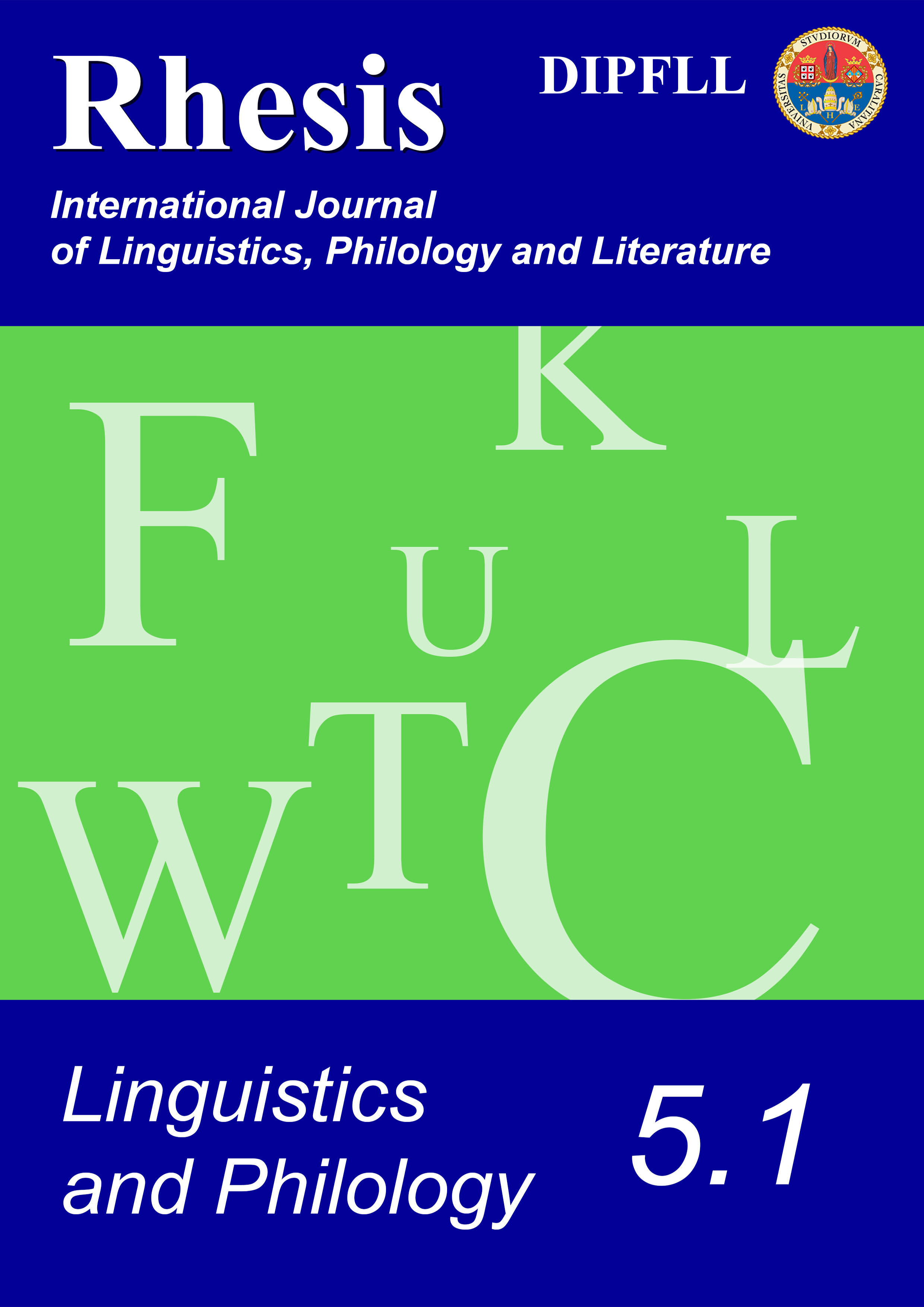British stereotypes in two humorous collections of postcards: A stylistic examination
Abstract
The How To Be British Collections (two booklets each composed of 32 comic postcards and equally comic comments) humorously portray the British showing their supposed national features. A representative sample from the booklets is scrutinised in this article by applying social psychological research on stereotypes with a stylistic approach. The main research purpose is to prove that the British stereotypes in the postcards are normally depicted as positive and those about foreigners and language learners as negative. Hence, the research hypothesis is that British culture and identity are extolled in the booklets, and that the non-British are represented as somehow deficient and flawed, in other words, as the actual grotesque characters in the postcards. Linguistic investigation indeed discloses that the British ethnic, social and cultural superiority over foreigners is implicitly celebrated in the booklets, along with their British protagonists and the appealing national characteristics typifying them. With regard to language learners, they allegedly lack politeness, heritage and the other positive aspects identified by social psychological studies; therefore, they are depicted as involved in ludicrous activities, a representation characterising them as hopelessly foolish and as mentally and even physically faulty.
Downloads
References
BELL, David (2012), “Tourism and hospitality”, in Tazim JAMAL and Mike ROBINSON (eds.), The Sage handbook of tourism studies. Thousand Oaks (CA): Sage, 19-34.
BROWN, Penelope, LEVINSON, Stephen C.(1987) [1978], Politeness: Some universals in language usage. Cambridge: Cambridge University Press.
BURKE, Michael (ed.) (2014), The Routledge handbook of stylistics. London: Routledge.
CONDOR, Susan (1996), “Unimagined community? Some social psychological issues concerning English national identity”, in Glynis M. BREAKWELL and Evanthia LYONS (eds.), Changing European identities: Social psychological analyses of social change. Oxford: Butterworth & Heinemann, 41-68.
CONDOR, Susan (1997), “‘Having history’: A social psychological exploration of AngloBritish autostereotypes”, in C. C. BARFOOT (ed.), Beyond Pug’s tour: National and ethnic stereotyping in theory and literary practice. Amsterdam & Atlanta (GA): Rodopi, 213-253.
EELEN, Gino (2001), A critique of politeness theories. Manchester: St Jerome.
ELLIGAN, Don (2008), “Stereotypes”, in Richard T. SCHAEFER (ed.), Encyclopedia of race, ethnicity, and society, Thousand Oaks (CA): Sage, ‹http://www.sageereference.com/ethnicity/Article_n532.html›
FORD, Martyn, LEGON, Peter (2003), The How to be British collection. Brighton: Lee Gone Publications.
FORD, Martyn, LEGON, Peter (2005), The How to be British collection two. Brighton:
Lee Gone Publications.
HINTON, Perry R. (2000), Stereotypes, cognition and culture. Hove: Psychology Press.
HOGG, Michael A. (2009), “Self-categorization theory”, in John M. LEVINE and Michael A. HOGG (eds.), Encyclopedia of group processes & intergroup relations, Thousand Oaks (CA): Sage, ‹http://www.sage-ereference.com/processes/Article_n223.html›
HUNTSINGER, Jeffrey R., SINCLAIR, Stacey (2009), “Self-stereotyping”, in John M. LEVINE and Michael A. HOGG (eds.), Encyclopedia of group processes & intergroup relations, Thousand Oaks (CA): Sage, ‹http://www.sageereference.com/processes/Article_n227.html›
INSCH, Andrea (2009), “Stereotyping”, in Charles WANKEL (ed.), Encyclopedia of business in today’s world, Thousand Oaks (CA): Sage, ‹http://www.sageereference.com/businesstoday/Article_n866.html›
JEFFRIES, Lesley, MCINTYRE, Dan (2010), Stylistics. Cambridge: Cambridge University Press.
JEFFRIES, Lesley (2010), Critical stylistics: The power of English: Perspectives on the English language. Basingstoke: Palgrave Macmillan.
LEECH, Geoffrey, SHORT, Mick (2007) [1981], Style in fiction: A linguistic introduction to English fictional prose, 2nd edn. London: Longman.
LIPPMANN, Walter (2012) [1922], Public Opinion. Mineola (NY): Courier Dover.
MAAS, Anne, ARCURI, Luciano (1996), “Language and stereotyping”, in C. Neil MACRAE, Charles STANGOR and Miles HEWSTONE (eds.), Stereotypes and stereotyping. London & New York: The Guilford Press, 193-226.
PICKERING, Michael (2006), Stereotyping: The politics of representation. Basingstoke: Palgrave.
PIZZICONI, Barbara (2006), “Politeness”, in Keith BROWN (ed.), Encyclopedia of language & linguistics (second edition), London: Elsevier, 679-684.
SIMPSON, Paul (2014) [2004], Stylistics: A resource book for students, 2nd edn. London: Routledge.
STANGOR, Charles, SCHALLER, Mark (1996), “Stereotypes as individual and collective representations”, in C. Neil MACRAE, Charles STANGOR and Miles HEWSTONE (eds.), Stereotypes and stereotyping. London & New York: The Guilford Press, 3-37.
STANGOR, Charles (ed.), (2000), Stereotypes and prejudice: Essential readings. Philadelphia (PA): Psychology Press.
STOCKWELL, Peter, WHITELEY, Sara (eds) (2014), The Cambridge handbook of stylistics. Cambridge: Cambridge University Press.
VAN DIJK, Teun A. (1987), Communicating racism: Ethnic prejudice in thought and talk. Thousand Oaks (CA): Sage.
VIRDIS, Daniela F. (2009), “Twentieth-century Sardinia in The National Geographic Magazine: A lexical analysis of a biased representation”, in Giuseppe MARCI and Simona PILIA (eds.), Minori e minoranze tra Otto e Novecento: Convegno di studi nel centenario della morte di Enrico Costa (1841-1909), Cagliari (Italy): CUEC, 129-148.
VIRDIS, Daniela F. (2012a), “Friendliness, aggressiveness and coarseness: Scottish Groundskeeper Willie’s linguistic features in The Simpsons”, in «NAWA: Journal of language and communication» 6 (1), 127-150.
VIRDIS, Daniela F. (2012b), Serialised gender: A linguistic analysis of femininities in contemporary TV series and media (Lagado Studi 7, general editors Giuseppe SERTOLI and Fabio CLETO). Genoa (Italy): ECIG.
WATTS, Richard J. (2003), Politeness. Cambridge: Cambridge University Press. WATTS, Richard J., IDE, Sachiko, EHLICH Konrad (eds.) (2005) [1992], Politeness in language: Studies in its history, theory and practice, 2nd edn. Berlin: Mouton de Gruyter.
WRIGHT, Stephen and TAYLOR, Donald (2007), “The social psychology of cultural diversity: Social stereotyping, prejudice, and discrimination”, in Michael A. HOGG and Joel COOPER (eds.), The Sage handbook of social psychology. Thousand Oaks (CA): Sage, 361-388.



